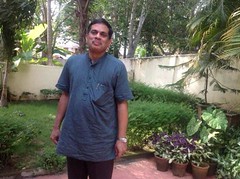
PREV ARTICLE
NEXT ARTICLE
FULL ISSUE
PREV FULL ISSUE
ARTICLE PROFILES BOOK AUTHOR JOSEPH THOMAS M.
This article from The Hindu profiles Dr. Joseph Thomas M., author of the new book, Legends of Travancore – A Numismatic
Heritage. -Editor
“Growing up in Thiruvananthapuram, it was not difficult to acquire coins particularly because I am a third generation resident of the city. I naturally had access to coins in circulation during my grandfather’s time. That was just a fancy. The collection kept growing. But it was in the last 15 years or so that coins have become a serious passion for me,” says Dr. Joseph, a urologist in Kasturba Medical College, Manipal. His progression from a mere coin collector to a genuine numismatist who learnt to use the coins to reconstruct the history of a period has found fruition in the book – Legends of Travancore – A Numismatic Heritage. How did he zero in on the coins of erstwhile Travancore as the subject for the book? “With a collection of coins from 300 countries (some of these countries have ceased to be, for instance, East European nations such as Yugoslavia, Czechoslovakia) and the numbers growing, I gradually narrowed down my interest to the coins of colonial India,” he says. Once the colonial powers set foot on the sub-continent, barter system gradually made way for more a concrete payment arrangement. The native states started their own methods of minting coins. Travancore and Venad became the focal point of his study. “For my personal use, I made a reference book that was a combination of catalogue-cum-history. Since access and availability of documents on the Travancore era were easier than the Venad phase of history, I commenced work on Travancore,” explains Dr. Joseph. The book draws on coins from ancient Travancore to narrate the political history, as well as the manner in which the coins were used within the social hierarchy. Since coinage fell within the Diwan’s functions, the mints of Travancore were located in different places, Padmanabhapuram, Kollam, Mavelikara and the Paravoor. Wherever there was a Cutchery, there was a mint. An interesting feature, according to the author, is that every mint (Kammattam) had a temple with Ganapathy as the presiding deity! Gazette notifications regarding such temples exist to confirm the practice of having a Ganapathy temple adjacent or close to the mint. The book, according to the author, offers illuminating details on the use of coins within the social hierarchy, the coming of the kaashu, phanam, chuckram, practice of thulabharam by the rulers, how the first machine-struck coins were issued under Maharaja Ayilyam Thirunal, changing dynamics in minting with the arrival of the British Resident, procuring coins from the Birmingham and Bombay mints, how documents reveal methods of identifying counterfeit coins, all nuggets that are interesting facets of Travancore history. To read the complete article, see:

Wayne Homren, Editor The Numismatic Bibliomania Society is a non-profit organization promoting numismatic literature. See our web site at coinbooks.org. To submit items for publication in The E-Sylum, write to the Editor at this address: whomren@gmail.com To subscribe go to: https://my.binhost.com/lists/listinfo/esylum All Rights Reserved. NBS Home Page Contact the NBS webmaster 
|
